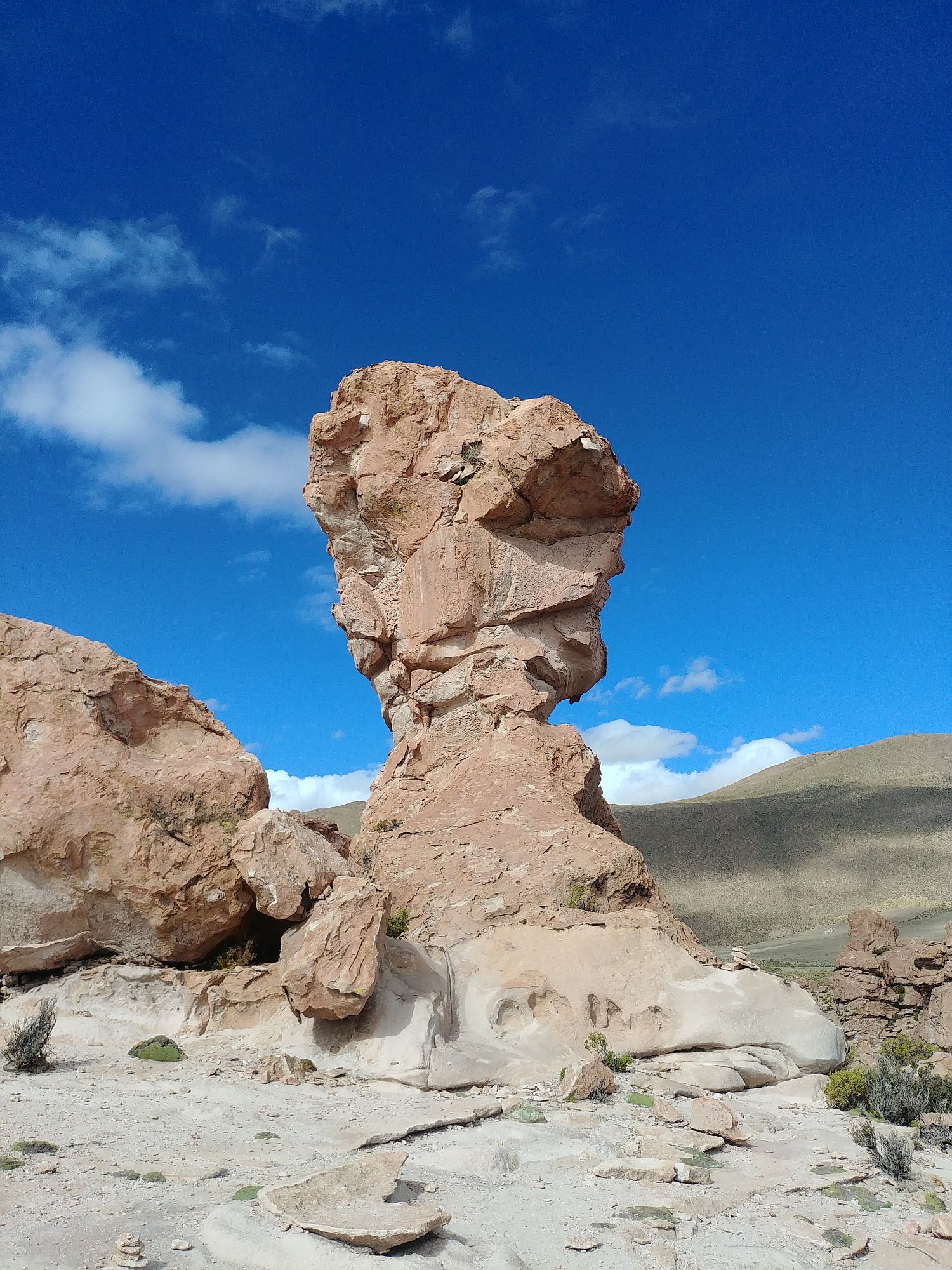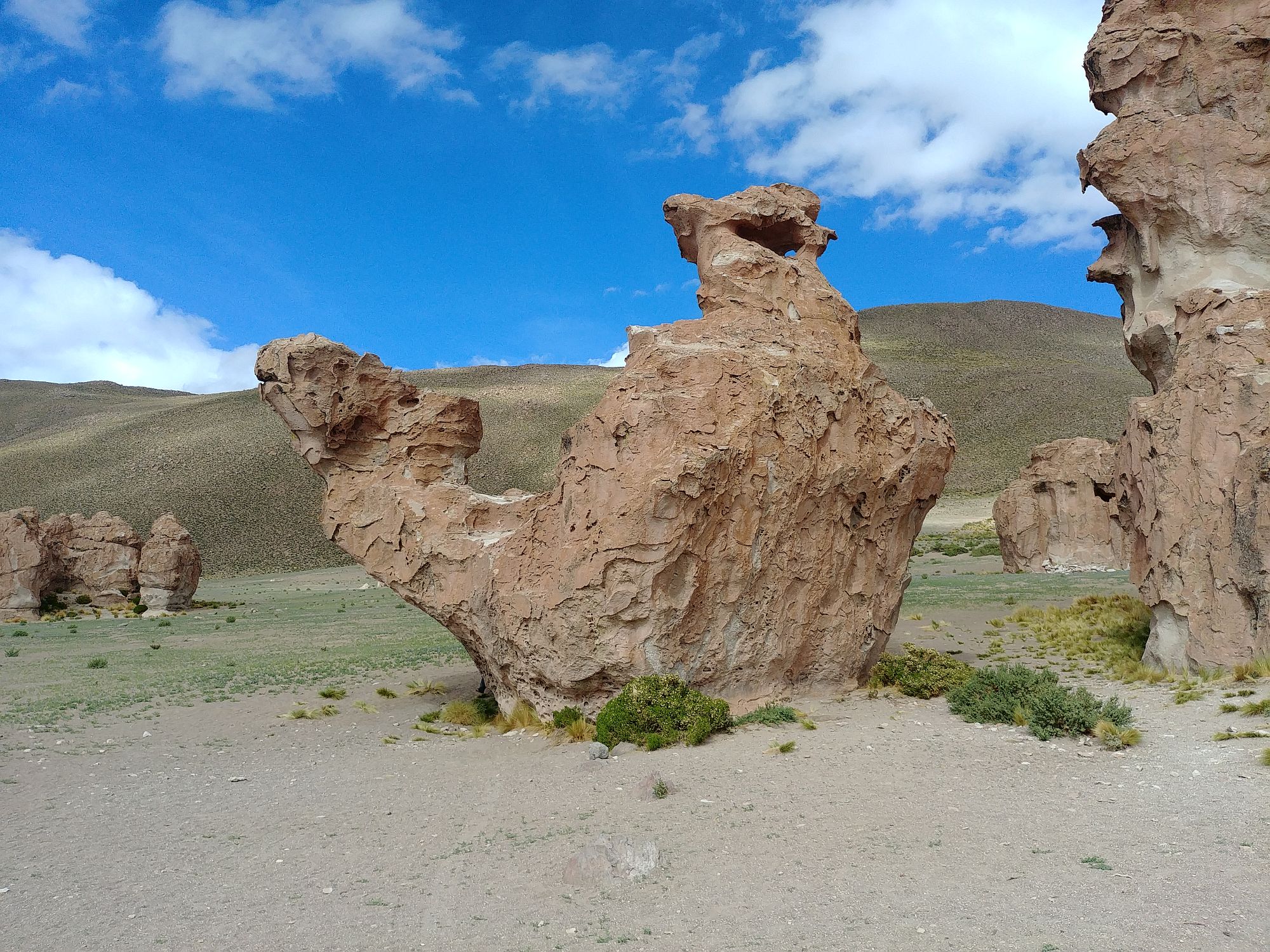
Salar de Uyuni tour day 2
Day 241 – Hostal del Sal, Bolivia
The breakfast was disappointing, so we didn’t linger. With too many tables for the servers, one table would have coffee but no cups, another cups and hot water but no coffee, so we traded.
I had cups, hot water and my own tea, so everything was going well for me!
We started by going to see rock formations. The first is around a pillar called Coppa del Mundo, World Cup, for its shape.

Coppa del Mundo – World Cup
I took some pictures of the local flora, scrubs, mosses, hardy plants that live so high.
The second rock formation is called Camelio – Camel, for its obvious shape!

Camelio
My Israelis co-travellers climbed on top to pretend to pilot the camel, that was funny.
The next rock formation we drove to is called Italia Perdida, Lost Italia. I would guess that the rocks would remind visitors of monuments in ruin?

Italia Perdida – Lost Italia
We stopped quickly then at another lake with flamingos for me. Alas, they still prefer to linger far from the shore, so my pictures are blurry, but still, flamingos. In the wild.
The next place we stopped at was magical. It is called Laguna Negra (see picture header), it is a lake well hidden in the surrounding rocks. Several flat and narrow valleys, covered in moss-like grass with water -pool, streams…- are joined or separated by protruding rocks. in the middle of it all you have the Laguna Negra (Black Lake), progressively revealed as you climb the surrounding rocky spines.

Laguna Negra – Next valley
We saw what could be a viscacha, a rodent that looks like a rabbit but with a long, furry tail. It blends so well in the surrounding rocks that you need to wait for them to move to see them!
Lamas graze in the valleys, obviously domesticated animals with bells and coloured ribbons to mark them. Our guide went in the middle of the herd to make them move away… and closer to where we could take pictures!
We stopped next on the top of a canyon -there were quinoa plantations around, quinoa doesn’t look like a cereal but like a small, green bush. At the bottom a sinuous river could be seen, called Anaconda for its shape. To see it, we climbed on a narrow promontory. (I shudder to all the dangerous climbing we can do as tourist, without any rail or warning!)
We had lunch then in a dusty town. Another car had to change a wheel, obviously an operation well-practiced as it took the driver only a few minutes!
We stopped in another town further on for one hour where a minimarket had wi-fi for a fee. A neighbour also had a vicuna in a pen, something whose legality I’m not sure of, as the vicuna is protected at least in Chile and Peru, and cannot be hunted in Bolivia.
Another pen contained what I think is rheas, a small ostrich-like bird.
We beat the rain to our last stop of the day, our hostel. It’s supposed to be made with salt blocks, in reality, it is a brick building with salt bricks covering the walls inside. You see well the tourist part and the non-tourist part! Platforms of salt bricks are used for the beds, stools, tables, and the common area was a sunken pit filled with salt gravel.
Because of the rainstorm, we had no electricity and no hot water -the shower again weren’t free, something we weren’t warned of, but we didn’t pay for cold water.
We had candles in our room and for diner, and of course our own torches.
Quelle splendeur! Tes images sont magnifiques, et ce que tu vois doit l’être encore plus! Tu tires même profit des rideaux de pluie pour faire des merveilles!
Merci aussi pour les photos de la vie quotidienne, des villes, des rues, des gens ( quand il y en a) et des masses de landrover de touristes!
Et j’ai bien vu les flamands roses!
“lost italia”: on pourrait imaginer que le trou entre les 2 rochers ressemble vaguement à la botte de l’Italie, non?